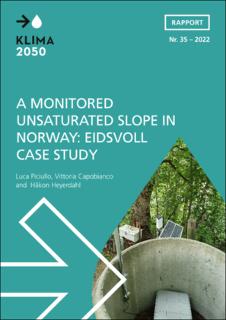| dc.description.abstract | In steep unsaturated slopes, the unsaturated region has a crucial role in maintaining the slope stability. In this work, the hydrological behaviour of a natural unsaturated slope located adjacent to a railway track in Eastern Norway has been modelled. Due to its steep inclination, the slope is monitored, and its stability is kept under frequent observation. The commercial software GeoStudio was used to create and calibrate a model able to replicate the in-situ monitored soil water content conditions. Six simulations were carried out by changing the initial and boundary climate conditions of the slope. The simulations conducted were divided into two main series: one with an initial calibration of the VWC profile (C), and another with no calibration (NC). For each of them, three different surface boundary conditions were applied: i) only precipitation, ii) precipitation and atmospheric conditions, iii) precipitation, atmospheric conditions and vegetation, according to the Penman-Monteith equation for evapotranspiration. The simulations have been validated though the use of Taylor diagrams that graphically summarize how closely a pattern (or a set of patterns) matches observations. The results show that including an initial calibration, climate conditions and vegetation, is crucial to best model the response of an unsaturated slope in Norway. The effectiveness of the best simulation in back-calculating soil water content, was tested for 3 different time periods: 3-month, 6-month, 1-year. The results show that the hydrological model can adequately represent the real monitored conditions up to a 6-month period, afterward a recalibration is needed. In addition, a coupled seepage and slope stability analysis for the 6-month period has been carried out. The calculated FS varies up to 18% depending on the complexity of the boundary conditions used in the model. The findings of this work can be seen as a preliminary step towards a real-time slope stability analysis and local landslide early warning system (Lo-LEWS). | en_US |
